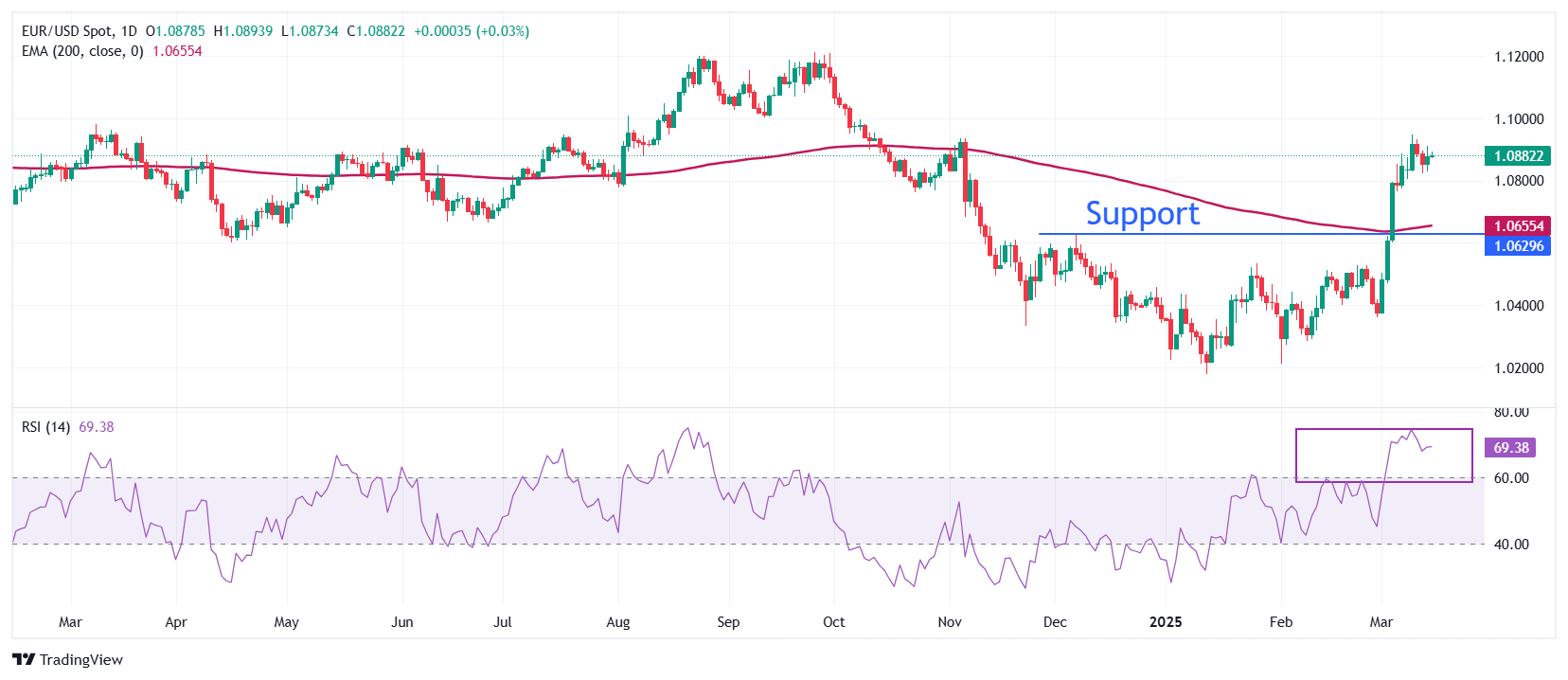- EUR/USD edges toward 1.0900 at the start of the week as investors await the Federal Reserve’s policy decision on Wednesday.
- While the Fed is expected to keep interest rates unchanged, market attention turns to the dot plot and Powell’s remarks.
- Signs of a German debt restructuring deal and optimism over a potential Russia-Ukraine peace agreement could support the Euro.
EUR/USD rises near 1.0900 during North American trading on Monday, driven by a weaker US Dollar (USD) as investors grow cautious ahead of the Federal Reserve’s (Fed) interest rate decision on Wednesday. The US Dollar Index (DXY), which measures the Greenback against six major currencies, declines to around 103.50.
With the Fed widely expected to keep interest rates unchanged in the 4.25%-4.50% range, market focus shifts to the dot plot, which outlines policymakers’ interest rate projections, along with updates on growth, employment, and inflation in the Summary of Economic Projections (SEP). In its December meeting, the Fed had signaled two potential rate cuts for this year.
Traders will also closely watch Fed Chair Jerome Powell’s remarks on the US economic outlook during his post-meeting press conference. Concerns over economic turbulence have grown following comments from key US officials. President Donald Trump has acknowledged that tariff policies could trigger short-term economic disruptions. Meanwhile, US Treasury Secretary Scott Bessent stated in a Sunday interview with NBC News that while the administration is implementing strong and durable policies, some adjustments may be necessary, suggesting a shift away from excessive government spending.
Last week, US Commerce Secretary Howard Lutnick emphasized the significance of Trump’s policies, stating they are "worth it" despite concerns that they could lead to a recession. Investors worry that tariffs may fuel inflation and strain consumer spending, creating a challenging environment for the US economy and weighing on the US Dollar.
On the data front, weaker-than-expected US Retail Sales figures for February have added to the pressure on the Greenback. Retail Sales, a key indicator of consumer spending, increased by just 0.2%, falling short of the 0.7% forecast. This follows a 1.2% decline in January, signaling potential weakness in consumer demand.
Daily Market Movers: EUR/USD Rises Despite Euro Weakness
- EUR/USD moves higher, driven by significant weakness in the US Dollar (USD), despite the Euro (EUR) struggling to gain momentum. German leaders, including the Greens led by Franziska Brantner, have agreed to establish a €500 billion infrastructure fund and implement major changes to borrowing rules, including adjustments to the so-called “debt brake,” which is expected to pass in the lower house of Parliament on Tuesday.
- Market participants anticipate that Germany’s decision to boost defense spending through a historic debt brake reform will support economic growth. A Reuters poll conducted from March 10-14 showed economists raising their Eurozone growth projections for 2026 to 1.3%, up from 1.2% in the previous month, driven by optimism over these fiscal reforms.
- The restructuring plan has also increased inflation expectations in the Eurozone, contrasting with the European Central Bank’s (ECB) current stance on monetary expansion. On Friday, ECB policymaker and Austrian Central Bank Governor Robert Holzmann advocated for keeping interest rates steady in April, citing concerns that US President Donald Trump’s tariffs and Germany’s defense spending could reignite inflationary pressures.
- Meanwhile, optimism surrounding a potential Russia-Ukraine truce is strengthening the Euro’s outlook. Trump is set to meet with Russian President Vladimir Putin on Tuesday to discuss a possible peace deal, following Ukraine’s recent acceptance of a 30-day ceasefire after negotiations with US officials in Saudi Arabia.
- However, a potential US-European Union (EU) trade conflict poses a significant risk to the Euro. On Thursday, President Trump threatened to impose 200% tariffs on European alcohol in response to the EU’s proposed retaliatory tariffs against the US for its 25% blanket levy on imported steel and aluminum. During European trading hours on Monday, ECB Vice President Luis de Guindos warned that a trade war would be detrimental to the global economy, stating, “Everyone loses in that situation.”
Technical Analysis: EUR/USD Approaches 1.0900

EUR/USD climbs toward 1.0900 on Monday, maintaining a strong long-term outlook as it trades above the 200-day Exponential Moving Average (EMA), currently around 1.0655.
The pair gained momentum after breaking decisively above the December 6 high of 1.0630 last week, reinforcing its bullish trajectory. Meanwhile, the 14-day Relative Strength Index (RSI) hovers near 70.00, signaling that the uptrend remains intact.
On the downside, the December 6 high of 1.0630 serves as a key support level, while the psychological resistance at 1.1000 will be a crucial hurdle for Euro bulls.





